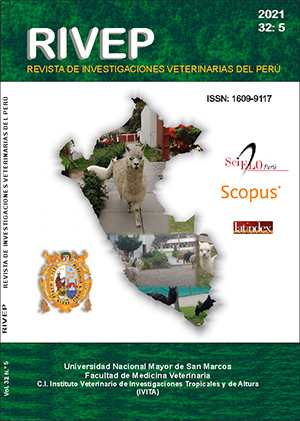Demographic characteristics of the canine population of a city in Patagonia, Argentina: Implications for the management of the canine population and human health
DOI:
https://doi.org/10.15381/rivep.v32i5.19430Keywords:
demography of dogs with owners, dog ownership, zoonosis, bites, ArgentinaAbstract
The demographic characteristics of the canine population, the traits of animal care and the occurrence of dog bites or traffic accidents caused by dogs in homes in San Carlos de Bariloche were investigated, in the context of a study on the impact of dog ownership on the environment and the health of the population. A survey was conducted in a stratified, multistage, and probabilistic household sample. The proportion of households with dogs was 69% and it was estimated that there were 57 082 owned dogs in the city. The 46% had free access to public spaces. Among these, 57% had not been vaccinated and 90% had not been dewormed in the last year or had been less than four times. Besides, 31% of the males and 77% of the females were neutered, while only 48% of the bitches under three years of age were spayed. In 5% of the households, one of their members had been bitten by a dog and in 19% one of the members had suffered a traffic accident caused by dogs in the last five years. The lack of supervision of dogs by their owners provides adequate conditions for the uncontrolled increase in the canine population, the spread of zoonotic diseases, the occurrence of dog bites and traffic accidents.
Downloads
Downloads
Published
Issue
Section
License
Copyright (c) 2021 Gilda Garibotti, Ana Laura Guardamagni, Daniela Zacharías, Gustavo Viozzi, Verónica Flores, Basilia Alvarado, Rodrigo Bustamante, Elizabeth Chang Reissig, Tomás González, Carlos Rauque, Karina Santos, Rocío Vega, Melani Walker

This work is licensed under a Creative Commons Attribution 4.0 International License.
AUTHORS RETAIN THEIR RIGHTS:
a. Authors retain their trade mark rights and patent, and also on any process or procedure described in the article.
b. Authors retain their right to share, copy, distribute, perform and publicly communicate their article (eg, to place their article in an institutional repository or publish it in a book), with an acknowledgment of its initial publication in the Revista de Investigaciones Veterinarias del Perú (RIVEP).
c. Authors retain theirs right to make a subsequent publication of their work, to use the article or any part thereof (eg a compilation of his papers, lecture notes, thesis, or a book), always indicating the source of publication (the originator of the work, journal, volume, number and date).



